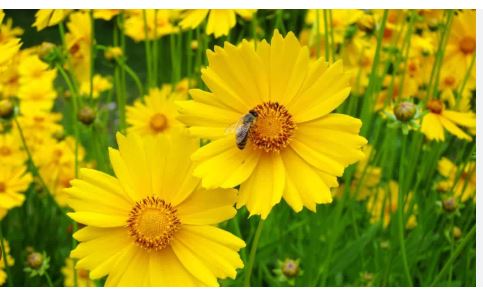
Coreopsis is a genus within the Asteraceae family, commonly known as the aster, daisy, or sunflower family. The name “Coreopsis” is derived from the Greek words “koris” (bug) and “opsis” (appearance), referring to the shape of the seed which resembles a bug or tick, leading to the common name “Tickseed.” There are over 80 species in the Coreopsis genus, with characteristics including bright, daisy-like flowers that are often yellow but can also be red, pink, or bi-colored in cultivated varieties.
Coreopsis species are predominantly native to North America, with a few species extending into Central and South America. They are widespread across the continent, from Canada down through the United States, with species adapted to various environments like prairies, meadows, woodlands, and disturbed areas. Some species, like Coreopsis lanceolata and Coreopsis grandiflora, are particularly noted for their occurrence in the eastern and central U.S., while others like Coreopsis tinctoria are found in the western regions and Great Plains.
Historically, Coreopsis has been valued for both its ornamental beauty and practical uses. Indigenous peoples in North America used certain species for dyeing materials, giving some species like Coreopsis tinctoria the name “Plains Coreopsis” due to its use by Plains Indians. With European settlement, Coreopsis became popular in gardens for its vivid colors and long bloom time, attracting pollinators and adding cheer to landscapes. Florida even named Coreopsis leavenworthii as its state wildflower in 1991, highlighting its ecological and cultural significance. Over time, breeding has resulted in numerous cultivars, expanding the color range and growth habits available for gardeners.
Coreopsis species are adaptable to a wide range of USDA Hardiness Zones, generally spanning from Zones 3 to 10, although this can vary by species. For example, Coreopsis verticillata (Threadleaf Coreopsis) is hardy in Zones 4-9, while Coreopsis tinctoria can handle conditions from Zones 2-11, being more of an annual in colder zones. This broad adaptability makes Coreopsis a versatile plant for gardens across much of North America, appreciated for its drought tolerance, ease of care, and ability to thrive in both sunny and somewhat shady conditions, provided there’s good drainage. Its resilience and long bloom period make it a staple in perennial gardens, wildflower meadows, and pollinator gardens.
Coreopsis (Coreopsis spp.): Characteristics
- Flower Appearance: Features bright, daisy-like flowers with a central disk and radiating petals, predominantly yellow, but modern cultivars offer colors like red, pink, orange, and bi-colors.
- Bloom Time: Known for an extended blooming period, often from late spring through fall, providing long-lasting color in the garden.
- Growth Habit Growth varies among species; some are upright and clump-forming, while others like Coreopsis verticillata have a more spreading, mounding habit. Heights can range from 6 inches to 3 feet.
- Leaves: Leaves are typically opposite or whorled, with shapes varying from linear to lanceolate. Some species, like Coreopsis verticillata, have finely dissected, thread-like foliage.
- Root System: Has a fibrous root system, allowing for easy division for propagation but also contributing to its drought tolerance once established.
- Adaptability: Highly adaptable to various soil types, with a preference for well-drained, sandy or loamy soils. It can tolerate both full sun and partial shade, though flowering is best in full sun.
- Pollinator Attraction: Attracts bees, butterflies, and other pollinators, making it valuable in pollinator gardens and for supporting local biodiversity.
- Drought Tolerance: Once established, many Coreopsis species are drought-tolerant, making them suitable for xeriscaping or low-water landscapes.
- Maintenance: Low-maintenance; deadheading can encourage more blooms and prevent self-seeding where not desired, but many gardeners allow some seed heads for winter interest and natural reseeding.
- Ecological Role: Provides nectar and pollen for pollinators, and its seeds can be a food source for birds. It also plays a role in soil stabilization in natural settings due to its ability to colonize disturbed areas.
Coreopsis (Coreopsis spp.): Cultivation
- Site Selection: Choose a location with full sun for optimal flowering, though some species can tolerate partial shade. At least 6 hours of direct sunlight is ideal.
- Soil Preparation: Prefers well-drained, sandy or loamy soil. Amend heavy or clay soils with sand or organic matter to improve drainage. Coreopsis can tolerate poor soil but does best with moderate fertility.
- Planting: Plant in spring after the last frost or in fall. Space plants 12 to 18 inches apart, depending on the species’ mature size, to allow for air circulation and growth. Sow seeds directly or start indoors 6-8 weeks before the last frost for transplants.
- Watering: Water regularly until established. Once settled, Coreopsis is drought-tolerant but benefits from occasional deep watering during extended dry periods, especially in the first growing season.
- Mulching: A light layer of mulch can help retain soil moisture and suppress weeds, but keep it away from the plant’s crown to prevent rot and ensure good air circulation.
- Fertilization: Fertilize lightly in spring with a balanced, slow-release fertilizer. Over-fertilization can lead to lush foliage at the expense of flowers. Coreopsis thrives even in relatively poor soils.
- Pruning and Maintenance: Deadhead spent flowers to encourage further blooming and to prevent self-seeding where not wanted. Cutting back by about one-third after the first bloom can promote a second flush.
- Pest and Disease Management: Generally resistant, but watch for aphids or fungal diseases like powdery mildew in overly moist conditions. Good air circulation and avoiding overhead watering can prevent most issues.
- Propagation: Can be propagated by seeds, which should be sown directly in the garden or started indoors. Division is also effective, particularly in spring or fall every few years to rejuvenate older clumps.
- Winter Care: In colder zones, a light mulch can protect the roots from extreme cold. However, many Coreopsis species are hardy and can self-sow, ensuring their return in spring. In warmer zones, they might act as short-lived perennials or perennials.